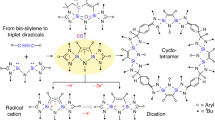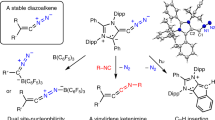Abstract
By flanking a carbene carbon with two substituents, it is possible to synthesize persistent triplet carbenes and isolable singlet carbenes. Isolable singlet carbenes are among the most powerful tools in chemistry, and they have even found medicinal and materials science applications. Between the rich chemistry of disubstituted carbenes and the transient parent carbene are the monosubstituted carbenes that, so far, have only been observed in matrices at very low temperatures of just a few K. Herein, we describe the synthesis of a crystalline monosubstituted carbene. The key for isolating such a species was to design the correct substituent, namely a benzo[c]pyrrolidino heterocycle, which can single-handedly tame the intrinsic tendency of carbenes towards dimerization. The π-donor ability of the nitrogen atom, coupled with the steric bulk of chemically inert substituents at the two adjacent quaternary carbons, make these scaffolds very attractive for the isolation of a variety of other hitherto elusive electron-deficient species.
This is a preview of subscription content, access via your institution
Access options
Access Nature and 54 other Nature Portfolio journals
Get Nature+, our best-value online-access subscription
$29.99 / 30 days
cancel any time
Subscribe to this journal
Receive 12 print issues and online access
$259.00 per year
only $21.58 per issue
Buy this article
- Purchase on Springer Link
- Instant access to full article PDF
Prices may be subject to local taxes which are calculated during checkout





Similar content being viewed by others
Data availability
Crystallographic data for the structures reported in this article have been deposited at the Cambridge Crystallographic Data Centre under deposition numbers CCDC 1814366 (2c), 1814371 (3c), 1814368 ((3c)Rh(cod)Cl), 1814370 (4b), 1835936 (5), 1814367 (7), 1814369 (8), 1814372 (9) and 1835937 (10). Copies of the data can be obtained free of charge via www.ccdc.cam.ac.uk/data_request/cif. All other data supporting the findings of this study are available within the article and its Supplementary Information, or from the corresponding author upon reasonable request.
References
Hollis, J. M., Jewell, P. R. & Lovas, F. J. Confirmation of interstellar methylene. Astrophys. J. 438, 259–264 (1995).
Hirai, K., Itoh, T. & Tomioka, H. Persistent triplet carbenes. Chem. Rev. 109, 3275–3332 (2009).
Díez-González, S. N-Heterocyclic Carbenes: From Laboratory Curiosities to Efficient Synthetic Tools (Royal Society of Chemistry, Cambridge, 2016).
Hopkinson, M. N., Richter, C., Schedler, M. & Glorius, F. An overview of N-heterocyclic carbenes. Nature 510, 485–496 (2014).
Mercs, L. & Albrecht, M. Beyond catalysis: N-heterocyclic carbene complexes as components for medicinal, luminescent, and functional materials applications. Chem. Soc. Rev. 39, 1903–1912 (2010).
Visbal, R. & Gimeno, C. N-heterocyclic carbene metal complexes: photoluminescence and applications. Chem. Soc. Rev. 43, 3551–3574 (2014).
Hindi, K. M., Panzner, M. J., Tessier, C. A., Cannon, C. L. & Youngs, W. J. The medicinal applications of imidazolium carbene–metal complexes. Chem. Rev. 109, 3859–3884 (2009).
Zhukhovitskiy, A. V., MacLeod, M. J. & Johnson, J. A. Carbene ligands in surface chemistry: from stabilization of discrete elemental allotropes to modification of nanoscale and bulk substrates. Chem. Rev. 115, 11503–11532 (2015).
Boydston, A. J., Williams, K. A. & Bielawski, C. W. A modular approach to main-chain organometallic polymers. J. Am. Chem. Soc. 127, 12496–12497 (2005).
Kamplain, J. W. & Bielawski, C. W. Dynamic covalent polymers based upon carbene dimerization. Chem. Commun. 2006, 1727–1729 (2006).
Boydston, A. J. & Bielawski, C. W. Bis(imidazolylidene)s as modular building blocks for monomeric and macromolecular organometallic materials. Dalton Trans. 2006, 4073–4077 (2006).
Eckhardt, A. K. & Schreiner, P. R. Spectroscopic evidence for aminomethylene (H–C̈–NH2)—the simplest amino carbene. Angew. Chem. Int. Ed. 57, 5248–5252 (2018).
Merceron, N., Miqueu, K., Baceiredo, A. & Bertrand, G. Stable (amino)(phosphino)carbenes: difunctional molecules. J. Am. Chem. Soc. 124, 6806–6807 (2002).
Lavallo, V. et al. Synthesis, reactivity, and ligand properties of a stable alkyl carbene. J. Am. Chem. Soc. 126, 8670–8671 (2004).
Melaimi, M., Jazzar, R., Soleilhavoup, M. & Bertrand, G. Cyclic (alkyl)(amino)carbenes (CAACs): recent developments. Angew. Chem. Int. Ed. 56, 10046–10068 (2017).
Lavallo, V., Canac, Y., Prasang, C., Donnadieu, B. & Bertrand, G. Stable cyclic (alkyl)(amino)carbenes as rigid or flexible, bulky, electron-rich ligands for transition metal catalysts: a quaternary carbon makes the difference! Angew. Chem. Int. Ed. 44, 5705–5709 (2005).
Buron, C., Gornitzka, H., Romanenko, V. & Bertrand, G. Stable versions of transient push–pull carbenes: extending lifetimes from nanoseconds to weeks. Science 288, 834–836 (2000).
Dielmann, F. et al. A crystalline singlet phosphinonitrene: a nitrogen atom–transfer agent. Science 337, 1526–1528 (2012).
Liu, L., Ruiz, D. A., Munz, D. & Bertrand, G. A singlet phosphinidene stable at room temperature. Chem 1, 147–153 (2016).
Hinsberg, W. D. & Dervan, P. B. Synthesis and direct spectroscopic observation of a 1,1-dialkyldiazene. Infrared and electronic spectrum of N-(2,2,6,6-tetramethylpiperidyl)nitrene. J. Am. Chem. Soc. 100, 1608–1610 (1978).
Schultz, P. G. & Dervan, P. B. Synthesis and direct spectroscopic observation of N-(2,2,5,5-tetramethylpyrrolidinyl)nitrene. Comparison of five- and six-membered cyclic 1,1-dialkyldiazenes. J. Am. Chem. Soc. 102, 878–880 (1980).
Dervan, P. B., Squillacote, M. E., Lahti, P. M., Sylwester, A. P. & Roberts, J. D. Nitrogen-15 NMR spectrum of a 1,1-diazene. N-(2,2,6,6-tetramethylpiperidyl)nitrene. J. Am. Chem. Soc. 103, 1120–1122 (1981).
Hinsberg, W. D., Schultz, P. G. & Dervan, P. B. Direct studies of 1,1-diazenes. Syntheses, infrared and electronic spectra, and kinetics of the thermal decomposition of N-(2,2,6,6-tetramethylpiperidyl)nitrene and N-(2,2,5,5-tetramethylpyrrolidyl)nitrene. J. Am. Chem. Soc. 104, 766–773 (1982).
Heidenbluth, K. & Scheffler, R. Isoindoline. 1. Synthese 1,1,2,3,3-pentasubstituierter isoindoline. J. Prakt. Chem. 23, 59–70 (1964).
Chan, K. S., Li, X. Z. & Lee, S. Y. Ligand-enhanced aliphatic carbon–carbon bond activation of nitroxides by rhodium(ii) porphyrin. Organometallics 29, 2850–2856 (2010).
Tapu, D., Dixon, D. A. & Roe, C. 13C NMR spectroscopy of “Arduengo-type” carbenes and their derivatives. Chem. Rev. 109, 3385–3407 (2009).
Alder, R. W., Allen, P. R., Murray, M. & Orpen, A. G. Bis(diisopropylamino)carbene. Angew. Chem. Int. Ed. 35, 1121–1123 (1996).
Dröge, T. & Glorius, F. The measure of all rings—N-hetrocyclic carbenes. Angew. Chem. Int. Ed. 49, 6940–6952 (2010).
Hudnall, T. W. & Bielawski, C. W. An N,N′-diamidocarbene: studies in C–H insertion, reversible carbonylation, and transition-metal coordination chemistry. J. Am. Chem. Soc. 131, 16039–16041 (2009).
Moerdyk, J. P., Schilter, D. & Bielawski, C. W. N,N′-diamidocarbenes: isolable divalent carbons with bona fide carbene reactivity. Acc. Chem. Res. 49, 1458–1468 (2016).
Liske, A., Verlinden, K., Buhl, H., Schaper, K. & Ganter, C. Determining the π-acceptor properties of N-heterocyclic carbenes by measuring the 77Se NMR chemical shifts of their selenium adducts. Organometallics 32, 5269–5272 (2013).
Back, O., Henry-Ellinger, M., Martin, C. D., Martin, D. & Bertrand, G. 31P NMR chemical shifts of carbene–phosphinidene adducts as an indicator of the π-accepting properties of carbenes. Angew. Chem. Int. Ed. 52, 2939–2943 (2013).
Rodrigues, R. R., Dorsey, C. L., Arceneaux, C. A. & Hudnall, T. W. Phosphaalkene vs. phosphinidene: the nature of the P–C bond in carbonyl-decorated carbene → PPh adducts. Chem. Commun. 50, 162–164 (2014).
Moerdyk, J. P. & Bielawski, C. W. Diamidocarbenes as versatile and reversible [2 + 1] cycloaddition reagents. Nat. Chem. 4, 275–280 (2012).
Turner, Z. R. Chemically non‐innocent cyclic (alkyl)(amino)carbenes: ligand rearrangement, C–H and C–F bond activation. Chem. Eur. J. 22, 11461–11468 (2016).
Moss, R. A. Carbenic selectivity in cyclopropanation reactions. Acc. Chem. Res. 13, 15–21 (1980).
Igau, A., Grutzmacher, H., Baceiredo, A. & Bertrand, G. Analogous α,α′-bis-carbenoid, triply bonded species: synthesis of a stable λ3-phosphino carbene-λ5-phosphaacetylene. J. Am. Chem. Soc. 110, 6463–6466 (1988).
Arduengo, A. J. III, Harlow, R. L. & Kline, M. A stable crystalline carbene. J. Am. Chem. Soc. 113, 361–363 (1991).
Avila, L. Z., Loo, S. H. & Frost, J. W. Chemical and mutagenic analysis of aminomethylphosphonate biodegradation. J. Am. Chem. Soc. 109, 6758–6764 (1987).
Kehlbeck, J. D. et al. A practical and efficient synthesis of 5′-substituted m-terphenyls. Synthesis 2007, 1979–1983 (2007).
Sevov, C. S. & Hartwig, J. F. Iridium-catalyzed oxidative olefination of furans with unactivated alkenes. J. Am. Chem. Soc. 136, 10625–10631 (2014).
Gray, I. P., Bhattacharyya, P., Slawin, A. M. Z. & Woollins, J. D. A new synthesis of (PhPSe2)2 (Woollins reagent) and its use in the synthesis of novel P–Se heterocycles. Chem. Eur. J. 11, 6221–6227 (2005).
Acknowledgements
Thanks are due to the NSF (CHE-1661518) for financial support of this work, and the Japan Society for the Promotion of Science for a Postdoctoral Fellowship for Study Abroad (to R.N.). We are grateful to the W. M. Keck Foundation for funding the Keck II computer centre, and A. L. Rheingold, M. Gembicky and C. E. Moore (X-ray diffraction).
Author information
Authors and Affiliations
Contributions
R.N. and G.B. devised the project. All authors discussed the results and wrote the paper. R.N. performed the experimental and computational work. R.J. performed the X-ray crystallographic analyses.
Corresponding author
Ethics declarations
Competing interests
The authors declare no competing interests.
Additional information
Publisher’s note: Springer Nature remains neutral with regard to jurisdictional claims in published maps and institutional affiliations.
Supplementary information
Supplementary information
Synthetic procedures, physical and spectroscopic properties for all compounds described in the manuscript, a copy of their NMR spectra, crystallographic data and structure refinements for compounds 2c, 3c, (3c)Rh(cod)Cl, 4b, 5, 7, 8, 9 and 10, and the Cartesian coordinates of computational structures
Crystallographic data
CIF for compound 2c; CCDC reference: 1814366
Crystallographic data
CIF for compound 3c; CCDC reference: 1814371
Crystallographic data
CIF for compound (3c)Rh(cod)Cl; CCDC reference: 1814368
Crystallographic data
CIF for compound 4b; CCDC reference: 1814370
Crystallographic data
CIF for compound 5; CCDC reference: 1835936
Crystallographic data
CIF for compound 7; CCDC reference: 1814367
Crystallographic data
CIF for compound 8; CCDC reference: 1814369
Crystallographic data
CIF for compound 9; CCDC reference: 1814372
Crystallographic data
CIF for compound 10; CCDC reference: 1835937
Rights and permissions
About this article
Cite this article
Nakano, R., Jazzar, R. & Bertrand, G. A crystalline monosubstituted carbene. Nature Chem 10, 1196–1200 (2018). https://doi.org/10.1038/s41557-018-0153-1
Received:
Accepted:
Published:
Issue Date:
DOI: https://doi.org/10.1038/s41557-018-0153-1
This article is cited by
-
Synthesis and reactivity of copper carbyne anion complexes
Nature Synthesis (2023)
-
Direct and selective access to amino-poly(phenylene vinylenes)s with switchable properties by dimerizing polymerization of aminoaryl carbenes
Nature Communications (2021)
-
Synthesis, properties, and catalysis of p-block complexes supported by bis(arylimino)acenaphthene ligands
Communications Chemistry (2020)



